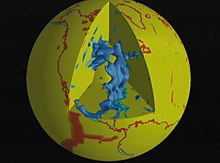

In geology, the slab is a significant constituent of subduction zones.[1]
Subduction slabs drive plate tectonics by pulling along the lithosphere to which they attach in a process known as slab pull and by inducing currents in the mantle via slab suction.[2] The slab affects the convection and evolution of the Earth's mantle due to the insertion of the hydrous oceanic lithosphere.[3] Dense oceanic lithosphere retreats into the Earth's mantle, while lightweight continental lithospheric material produces active continental margins and volcanic arcs, generating volcanism.[4] Recycling the subducted slab presents volcanism by flux melting from the mantle wedge.[5] The slab motion can cause dynamic uplift and subsidence of the Earth's surface, forming shallow seaways[2] and potentially rearranging drainage patterns.[6]
Geologic features of the subsurface can infer subducted slabs by seismic imaging.[7][8] Subduction slabs are dynamic; slab characteristics such as slab temperature evolution, flat-slab, deep-slab, and slab detachment can be expressed globally near subduction zones.[9] Temperature gradients of subducted slabs depend on the oceanic plate's time and thermal structures.[10] Slabs experiencing low angle (less than 30 degrees) subduction is considered flat-slab, primarily in southern China and the western United States.[11][12] Marianas Trench is an example of a deep slab, thereby creating the deepest trench in the world established by a steep slab angle.[13] Slab breakoff occurs during a collision between oceanic and continental lithosphere,[14] allowing for a slab tear; an example of slab breakoff occurs within the Himalayan subduction zone.[4]
- ^ Conrad, C. P. "How Mantle Slabs Drive Plate Motions". Archived from the original on June 13, 2011. Retrieved 24 April 2011.
- ^ a b Mitrovica, J. X.; Beaumont, C.; Jarvis, G. T. (1989). "Tilting of continental interiors by the dynamical effects of subduction". Tectonics. 8 (5): 1079. Bibcode:1989Tecto...8.1079M. doi:10.1029/TC008i005p01079.
- ^ Wada, Ikuko; Behn, Mark D.; Shaw, Alison M. (2012-11-01). "Effects of heterogeneous hydration in the incoming plate, slab rehydration, and mantle wedge hydration on slab-derived H2O flux in subduction zones". Earth and Planetary Science Letters. 353–354: 60–71. Bibcode:2012E&PSL.353...60W. doi:10.1016/j.epsl.2012.07.025. ISSN 0012-821X.
- ^ a b Frisch, Wolfgang; Meschede, Martin; Blakey, Ronald (2011), "Subduction zones, island arcs and active continental margins", Plate Tectonics, Berlin, Heidelberg: Springer Berlin Heidelberg, pp. 91–122, doi:10.1007/978-3-540-76504-2_7, ISBN 978-3-540-76503-5, retrieved 2021-12-10
- ^ Iwamori, Hikaru (1998-07-01). "Transportation of H2O and melting in subduction zones". Earth and Planetary Science Letters. 160 (1): 65–80. Bibcode:1998E&PSL.160...65I. doi:10.1016/S0012-821X(98)00080-6. ISSN 0012-821X.
- ^ Shephard, G. E.; Müller, R. D.; Liu, L.; Gurnis, M. (2010). "Miocene drainage reversal of the Amazon River driven by plate–mantle interaction". Nature Geoscience. 3 (12): 870–75. Bibcode:2010NatGe...3..870S. CiteSeerX 10.1.1.653.4596. doi:10.1038/ngeo1017.
- ^ Rondenay, Stéphane; Abers, Geoffrey A.; van Keken, Peter E. (2008). "Seismic imaging of subduction zone metamorphism". Geology. 36 (4): 275. Bibcode:2008Geo....36..275R. doi:10.1130/G24112A.1. ISSN 0091-7613.
- ^ Zhao, Dapeng; Ohtani, Eiji (2009-12-01). "Deep slab subduction and dehydration and their geodynamic consequences: Evidence from seismology and mineral physics". Gondwana Research. 16 (3): 401–413. Bibcode:2009GondR..16..401Z. doi:10.1016/j.gr.2009.01.005. ISSN 1342-937X.
- ^ Hu, Jiashun; Gurnis, Michael (April 2020). "Subduction Duration and Slab Dip". Geochemistry, Geophysics, Geosystems. 21 (4). Bibcode:2020GGG....2108862H. doi:10.1029/2019GC008862. ISSN 1525-2027. S2CID 216305697.
- ^ Holt, A. F.; Condit, C. B. (June 2021). "Slab Temperature Evolution Over the Lifetime of a Subduction Zone". Geochemistry, Geophysics, Geosystems. 22 (6). Bibcode:2021GGG....2209476H. doi:10.1029/2020GC009476. ISSN 1525-2027. S2CID 232378621.
- ^ Schellart, Wouter Pieter (2020). "Control of Subduction Zone Age and Size on Flat Slab Subduction". Frontiers in Earth Science. 8: 26. Bibcode:2020FrEaS...8...26S. doi:10.3389/feart.2020.00026. ISSN 2296-6463.
- ^ Liu, Xiaowen; Currie, Claire A. (2019). "Influence of Upper Plate Structure on Flat-Slab Depth: Numerical Modeling of Subduction Dynamics". Journal of Geophysical Research: Solid Earth. 124 (12): 13150–13167. Bibcode:2019JGRB..12413150L. doi:10.1029/2019JB018653. ISSN 2169-9356. S2CID 210254422.
- ^ Gvirtzman, Zohar; Stern, Robert J. (April 2004). "Bathymetry of Mariana trench-arc system and formation of the Challenger Deep as a consequence of weak plate coupling". Tectonics. 23 (2): n/a. Bibcode:2004Tecto..23.2011G. doi:10.1029/2003tc001581. ISSN 0278-7407. S2CID 21354196.
- ^ Huw Davies, J.; von Blanckenburg, Friedhelm (1995-01-01). "Slab breakoff: A model of lithosphere detachment and its test in the magmatism and deformation of collisional orogens". Earth and Planetary Science Letters. 129 (1): 85–102. Bibcode:1995E&PSL.129...85D. doi:10.1016/0012-821X(94)00237-S. ISSN 0012-821X.